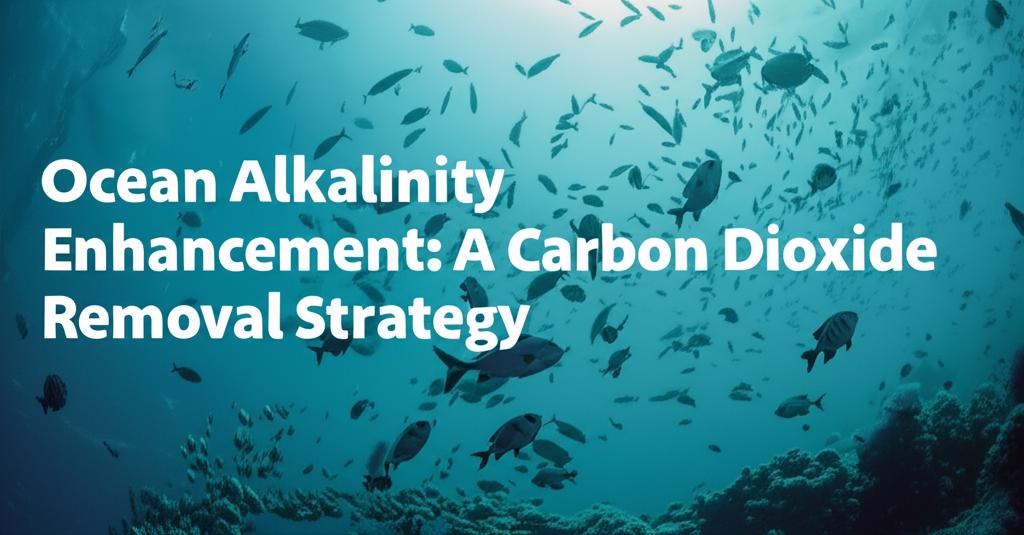The ocean plays a crucial role in the global carbon cycle, acting as the largest carbon dioxide (CO2) reservoir on Earth. Ocean Alkalinity Enhancement (OAE) is a carbon dioxide removal (CDR) strategy that aims to accelerate the ocean's natural ability to absorb and store atmospheric CO2. This is achieved by adding alkaline substances to seawater, which increases its pH and enhances its capacity to take up CO2 from the atmosphere. The absorbed CO2 is then converted into stable bicarbonate and carbonate ions, effectively locking it away for thousands of years.
Recent Advancements and ResearchRecent research and field trials have provided valuable insights into the feasibility, effectiveness, and potential environmental impacts of OAE.
- Effectiveness and Safety: A "world-first" field trial published in Nature Communications demonstrated that properly controlled OAE, using magnesium hydroxide added to wastewater, can effectively sequester CO2. The study indicated that any environmental effects were temporary and highly localized, suggesting minimal risk. Another study by GEOMAR Helmholtz Centre for Ocean Research Kiel found that moderate OAE had a minimal impact on zooplankton.
- Methods and Materials: Various alkaline materials are being explored, including olivine, limestone (calcite), and magnesium-based minerals. Electrochemical approaches, which involve splitting seawater into acidic and basic components and reintroducing the basic component to the ocean, are also under investigation. Research using calcite has shown promise, particularly in areas like the Baltic Sea where waters are naturally undersaturated in calcite. The dissolution of quicklime (CaO) is also being studied due to its rapid near-surface dissolution, which is crucial for atmospheric CO2 uptake.
- Modeling and Monitoring: Scientists are using computer models to simulate OAE processes and assess their large-scale potential. Tools are being developed to map the efficiency of OAE and understand how it varies geographically and temporally. Monitoring, reporting, and verification (MRV) of CO2 sequestration remain key areas of research, as accurately measuring the amount of CO2 removed and stored is technically complex.
- Synergistic Applications: Researchers are exploring integrating OAE with existing infrastructure, such as wastewater treatment plants and coastal engineering projects, to potentially reduce implementation costs.
Despite promising developments, several challenges and uncertainties need to be addressed for large-scale OAE deployment:
- Environmental Impacts: While initial studies show minimal localized impacts, the long-term and large-scale ecological effects of altering ocean chemistry are not yet fully understood. Potential impacts on marine ecosystems, nutrient cycles, and local water chemistry require careful study and monitoring. The risk of secondary precipitation, where added alkalinity might cause calcium carbonate to precipitate out of the water, reducing OAE efficiency, is also a concern being investigated.
- Logistical and Economic Considerations: The mining, grinding, transportation, and distribution of large quantities of alkaline materials present significant logistical and economic challenges. The energy required for these processes, and for electrochemical methods, must be factored into the overall carbon removal benefits. Cost estimates for OAE vary, and it is considered one of the more expensive CDR techniques.
- Public Acceptance and Governance: Ensuring that OAE is environmentally sustainable and socially acceptable is crucial for its implementation. International cooperation, robust governance frameworks, and standardized research practices are needed to manage risks and ensure projects align with global climate goals. Initiatives like the "Guide to Best Practices for Ocean Alkalinity Enhancement Research" aim to support this.
OAE holds significant potential as a scalable CDR method with the co-benefit of counteracting ocean acidification. Continued research, including carefully designed and monitored pilot studies under field conditions, is essential to address the remaining uncertainties regarding efficiency, environmental impacts, and cost-effectiveness. Many research efforts are underway to improve the knowledge base in a timely manner. As research progresses, OAE could become a crucial tool in the portfolio of solutions needed to achieve net-zero emissions and mitigate climate change.

